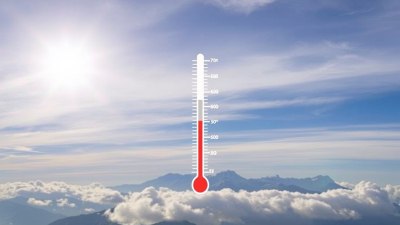Why Everything Becomes a Debate When It’s Too Hot to Think
Explore how extreme heat affects cognition and social dynamics, turning simple topics into intense debates.

Image created with Flux Schnell
Heat has long been known to influence human behavior in profound ways. When temperatures rise, people often become more irritable, less patient, and surprisingly more argumentative. This shift in mood and behavior can transform even the simplest interactions into heated debates. But why does this happen? How does excessive heat alter our thinking processes and make us more prone to conflict? This article explores the psychological and physiological effects of heat on the human brain, how hot weather impacts communication, and what can be done to mitigate these effects to preserve calm and rational discussions.
The Link Between Heat and Human Behavior
Scientific studies consistently demonstrate that hotter temperatures are correlated with increased aggression and social conflict. Heat stress activates the body's physiological responses, including elevated heart rate and increased blood flow, which can prime individuals for heightened emotional states. This is often referred to as the "heat effect" or "temperature-aggression hypothesis." For example, a classic study found that violent crime rates tend to spike during heatwaves compared to cooler periods. This suggests that heat doesn’t just make us physically uncomfortable; it can also impair our ability to regulate emotions effectively.
The psychological theory behind this phenomenon involves the way heat triggers stress responses. When the body experiences heat stress, it releases stress hormones such as cortisol and adrenaline. These chemicals prepare the body for a fight-or-flight response, increasing alertness but also potentially reducing impulse control and increasing irritability. In social situations, this means that minor frustrations or misunderstandings are more likely to escalate into full-blown arguments.
How Heat Impacts Cognitive Functioning
Cognitive performance declines significantly under extreme heat conditions. The brain’s ability to focus, process information, and make balanced decisions diminishes as the body struggles to maintain homeostasis. Working memory and attention span are often impaired, making it difficult for individuals to engage in thoughtful dialogue. When cognition is compromised, people may misinterpret others’ intentions or overreact emotionally.
Psychologists have observed that heat can lead to more black-and-white thinking. Instead of being open to nuance or considering other viewpoints, people might become rigid and defensive. This cognitive narrowing means that debates become less about exchanging ideas and more about defending positions aggressively. When it’s too hot to think clearly, people might also struggle to find the words to express complex thoughts, resorting instead to simplistic or emotional responses.
Social Dynamics in High Heat
Social interactions are particularly vulnerable to the effects of heat. In group settings, rising temperatures can lead to a decrease in prosocial behaviors such as cooperation, empathy, and patience. Instead, there is an increase in misunderstandings and hostile exchanges. This dynamic is especially a concern in environments where multiple people are confined, such as offices, public transport, or crowded homes during heatwaves.
Research has shown that when people feel physically uncomfortable, their tolerance for others drops substantially. For instance, if someone raises their voice or interrupts during a conversation on a hot day, others may respond more aggressively than they would under cooler conditions. This creates a feedback loop where tension escalates quickly, turning minor disagreements into full-scale debates or arguments.
Urban Heat Islands and Their Impact on Community Behavior
Urban environments are particularly susceptible to intense heat due to the urban heat island effect, where concrete and asphalt absorb and radiate heat, making cities feel several degrees hotter than surrounding rural areas. This exacerbates stress and agitation among urban residents, contributing to increased social tensions. Studies in city environments consistently report higher rates of aggressive incidents during heat spikes, underscoring how environmental factors shape human interactions.
Moreover, urban heat can influence public spaces where people gather and socialize. Parks, markets, and even streets become sites of increased conflict when temperatures soar. The challenge in urban planning is to design cooler, shaded, and ventilated spaces that can help reduce these negative behavioral outcomes.
Why We Debate More When It's Hard to Think
Debates require a complex interplay of cognitive skills including listening, processing information, empathy, and the ability to regulate emotions. When the brain is impaired by heat, these functions fail to operate smoothly. Instead of engaging in productive discussions, people may cling to rigid beliefs and react defensively. The frustration of being cognitively compromised can itself drive people into argumentative stances as a way of asserting control.
This increased inclination toward debate and disagreement during heat waves can also be linked to social identity factors. When thinking clearly is difficult, people tend to rely more heavily on group identities and slogans, which can polarize discussions further. Heated environments thus can see a rise in tribalistic debates where each side is less willing to find common ground.
How Discomfort Amplifies Emotional Responses
Physical discomfort, such as excessive heat, lowers the threshold for emotional responses. When someone feels uncomfortable, their ability to tolerate frustration decreases, which often manifests as increased emotional reactivity. This can transform otherwise trivial topics into sources of conflict because the discomfort reduces patience and tolerance.
Heat-induced fatigue also plays a role, as tiredness impairs emotional regulation. When people are exhausted from heat exposure, they have fewer mental resources to remain calm or consider alternative perspectives. Consequently, debates escalate quicker than usual and become more charged with emotion.
The Neuroscience Behind Heat and Emotion
Neuroscientific research provides insights into how temperature affects brain function. The hypothalamus, which regulates body temperature, also interacts closely with brain areas responsible for emotional processing, such as the amygdala and prefrontal cortex. When body temperature rises excessively, communication between these regions can become disrupted.
This disruption means that the brain’s normal mechanisms for dampening emotional responses and promoting rational thought are weakened. The amygdala becomes more reactive, heightening feelings of anger and irritability, while the prefrontal cortex, which governs decision-making and impulse control, is less able to function optimally. This imbalance leads to a state where emotions dominate cognition, making reasoned debate more difficult.
Real-World Examples: Heat and Social Conflict
Historical and contemporary events provide compelling evidence of heat-related social tensions. For instance, several documented riots, protests, and aggressive outbreaks correlate closely with periods of extreme heat. One notable example includes the 1995 heatwave in Chicago, which saw a tragic increase in violence and social unrest.
On a smaller scale, everyday interactions frequently become more tense during hot weather. Customer service representatives report higher rates of complaints and aggressive behavior from customers in the summer months. Similarly, schools observe increased disciplinary issues during particularly warm days. These examples illustrate how heat can escalate conflict across various social settings.
Strategies to Mitigate Heat-Induced Debates
Understanding the relationship between heat and debate offers practical ways to reduce conflict. First, managing the physical environment is crucial. Access to air conditioning, fans, hydration, and shade greatly helps in lowering the psychological stress caused by heat. Encouraging breaks during heatwaves allows individuals time to cool down and collect their thoughts.
Second, awareness and communication strategies can be employed. Organizations and leaders can remind people that increased irritability during hot periods is common and encourage patience and empathy. Setting clear ground rules for discussions and promoting active listening may prevent confrontations from escalating.
Third, individuals can use personal coping mechanisms such as mindfulness, deep breathing, and taking time-outs to regulate emotions when feeling overwhelmed by heat and frustration. Recognizing early signs of heat-induced agitation enables people to step back from debates before they intensify.
Urban Planning and Policy Considerations
Policymakers and urban planners can play a significant role in addressing the behavioral effects of heat by designing cities to be more climate-resilient. Incorporating green spaces, increasing tree canopy coverage, and using reflective materials can reduce ambient temperatures. These environmental improvements not only reduce physical discomfort but also contribute to better mental health and social harmony.
Heat action plans that include public cooling centers, accessible water fountains, and community outreach programs help vulnerable populations cope with heat stress. Such measures have been shown to decrease heat-related conflicts and improve overall wellbeing.
The Role of Technology
Technological innovations also offer promising tools to combat the cognitive effects of heat. Smart building systems that automatically adjust cooling or ventilation can ensure indoor environments remain comfortable without manual intervention. Wearable devices monitoring body temperature and stress levels could alert users when they are at risk of heat-induced cognitive impairment.
Apps and platforms encouraging social connection and emotional regulation techniques may assist individuals in managing interpersonal conflicts exacerbated by heat. Combining technology with behavioral science creates opportunities to maintain healthy communication even in adverse conditions.
Further Research Directions
While existing research strongly supports the link between heat and increased debate or conflict, more studies are needed to understand the complexities fully. Future investigations could explore individual differences in heat sensitivity, cultural factors that influence heat-related behavior, and long-term effects of repeated heat stress on social dynamics.
Additionally, interdisciplinary research combining neuroscience, psychology, urban studies, and environmental science will enhance strategies to mitigate these issues. Understanding the full impact of climate change on human behavior is an urgent task as heat waves become more frequent and intense worldwide.
Excessive heat profoundly affects human cognition and behavior, making people more prone to debate and conflict. Physiological stress responses, impaired brain function, and emotional dysregulation under heat combine to decrease tolerance and rationality. Social dynamics become more fragile, especially in urban environments where heat is amplified. Recognizing the causes and consequences of this phenomenon enables individuals, organizations, and policymakers to implement effective measures that reduce tension and preserve constructive communication despite challenging environmental conditions.











